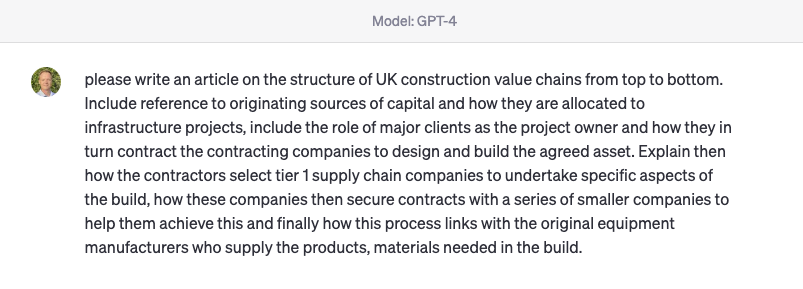Entering the Market Discovery Phase
As I outlined in my first article, the role of the knowledge worker is under threat. As a knowledge worker for the last 10 years and with about 20 years remaining in my career, I have decided to embark on an exploration into construction sector supply chains to see if I can transition my role to that of a commercial actor remunerated on performance.
The construction sector is one that I am familiar with, having supported research teams in bringing new products to market in collaboration with some of the UK’s best universities and Research Technology Organisations (RTOs). In conjunction with this work I spent a lot of time looking at ways in which the sustainability agenda was impacting construction and how access to investment at scale could be leveraged to support the introduction and development of new markets for innovative products.
The upper echelons of the UK Construction Value Chain comprises a large number of well established players. To identify possible opportunities my next step is to begin to narrow in on the part of the UK Construction Value Chain most likely to yield opportunities. I already have a clear idea of where to focus, however to put this in perspective it is worth highlighting each of the main elements of the UK Construction Value Chain.
To speed up the process of getting this information down I used ChatGPT to write the following article using the this prompt.
Here is what it produced…
Navigating the UK Construction Value Chain:
From Capital to Completion
Introduction
The UK construction industry plays a critical role in the country's economic growth and infrastructure development. A thorough understanding of the structure of the UK construction value chain is essential for anyone involved in the sector. In this article, we will examine the value chain from top to bottom, focusing on the flow of capital, the role of major clients, and the relationships among contracting companies, supply chain partners, and original equipment manufacturers (OEMs).
Originating Sources of Capital and Allocation to Infrastructure Projects
The capital required for infrastructure projects in the UK often originates from various sources, such as government budgets, private sector investment, public-private partnerships (PPPs), and institutional investors. This funding is then allocated to specific projects based on their strategic importance, feasibility, and expected return on investment.
Government budgets: The UK government allocates funds to infrastructure projects as part of its annual spending plans. These projects can include transportation, energy, water, and social infrastructure developments.
Private sector investment: Private companies may finance infrastructure projects independently or in collaboration with the public sector. This type of investment typically comes from large corporations, banks, or private equity firms.
Public-private partnerships (PPPs): PPPs are collaborative arrangements between the public and private sectors, where both parties share the risks and rewards of infrastructure development. This model allows for a more efficient allocation of resources and encourages innovation in project delivery.
Institutional investors: Pension funds, insurance companies, and sovereign wealth funds are examples of institutional investors that may invest in infrastructure projects to diversify their portfolios and generate long-term, stable returns.
2. The Role of Major Clients as Project Owners
Major clients, often referred to as project owners, are responsible for initiating and overseeing infrastructure projects. They can be government agencies, private companies, or public-private partnerships. The project owner's primary responsibilities include defining the project's scope, procuring funding, and selecting the contracting companies to design and build the asset.
3. Contracting Companies: Design and Build
Project owners typically engage contracting companies through competitive bidding or negotiated contracts. These companies are responsible for designing, constructing, and delivering the infrastructure asset. Contracting companies may operate as general contractors, managing the entire project, or as specialized contractors, focusing on specific aspects of the build.
4. Tier 1 Supply Chain Companies and Smaller Subcontractors
Contractors select tier 1 supply chain companies to undertake specific tasks within the project. These tasks can range from engineering and architectural design to materials supply and logistics. Tier 1 suppliers often secure contracts with smaller subcontractors to help them achieve their objectives, thus creating a multi-tiered supply chain structure.
5. The Link with Original Equipment Manufacturers (OEMs)
Original equipment manufacturers (OEMs) play a crucial role in the construction value chain, as they supply the necessary products and materials for the build. These can include heavy machinery, building materials, electrical and plumbing components, and various other items. Contractors and tier 1 supply chain companies typically establish contracts with OEMs to ensure timely delivery of quality products at competitive prices.
Conclusion
The UK construction value chain is a complex and interconnected network of stakeholders, including capital providers, project owners, contracting companies, tier 1 supply chain partners, subcontractors, and original equipment manufacturers. Understanding the structure and interdependencies within this value chain can help industry professionals make informed decisions, enhance collaboration, and ultimately contribute to more successful infrastructure projects.
By considering the UK Construction Value Chain in its entirety and understanding where major sources of investment capital are being allocated within the sector, I have narrowed down a good starting point for determining which possible niches to explore.
See my next article <Social Housing and Retrofit: Impacting Net Zero>


